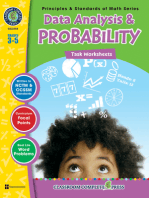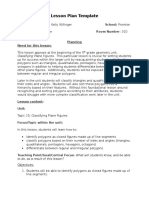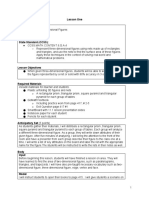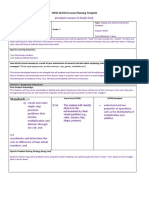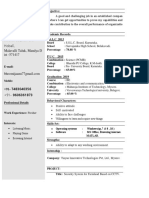0 ratings0% found this document useful (0 votes)
281 viewsPattern Unit Grade 4-5 Math Patterns Relations - Patterns
Pattern Unit Grade 4-5 Math Patterns Relations - Patterns
Uploaded by
api-190237046Copyright:
© All Rights Reserved
Available Formats
Download as DOCX, PDF, TXT or read online from Scribd
Pattern Unit Grade 4-5 Math Patterns Relations - Patterns
Pattern Unit Grade 4-5 Math Patterns Relations - Patterns
Uploaded by
api-1902370460 ratings0% found this document useful (0 votes)
281 views4 pagesOriginal Title
pattern unit grade 4-5 math patterns relations - patterns
Copyright
© © All Rights Reserved
Available Formats
DOCX, PDF, TXT or read online from Scribd
Share this document
Did you find this document useful?
Is this content inappropriate?
Copyright:
© All Rights Reserved
Available Formats
Download as DOCX, PDF, TXT or read online from Scribd
Download as docx, pdf, or txt
0 ratings0% found this document useful (0 votes)
281 views4 pagesPattern Unit Grade 4-5 Math Patterns Relations - Patterns
Pattern Unit Grade 4-5 Math Patterns Relations - Patterns
Uploaded by
api-190237046Copyright:
© All Rights Reserved
Available Formats
Download as DOCX, PDF, TXT or read online from Scribd
Download as docx, pdf, or txt
You are on page 1of 4
Teacher Name: Graeme McFarlane
Evaluation of Student Learning
Unit Assessment Plan
Subject Area Math
Grade Level Grade 4/5
Topic Patterns & Relations Patterns
Patterns
Identify Desired Results
What General Learner Outcomes are
being addressed?
What essential questions ties these
outcomes to real life?
Students will use patterns to describe
the world and to solve
problems.
Patterns and Relations (Patterns)
How does being able to identify and describe
patterns connect us to the world we live in?
Why are patterns important when riding a
bike, board, or flicker?
Reflecting on our lives, how do we live in a
pattern?
When playing rock band, mine craft, games
where KPS(keystrokes per second) is crucial,
how does identifying a pattern quickly help you
succeed?
What Specific Learner Outcomes are
being addressed as a result of this unit?
What essential and unit questions
will focus this unit meaningfully for
students?
Grade 4 SLOs (foundation)
1. Identify and describe patterns found in
tables and charts.
2. Translate among different representations of
a pattern, such as a table, a chart or concrete
materials.
3. Represent, describe and extend patterns and
relationships, using charts and tables, to solve
problems.
4. Identify and explain mathematical
relationships, using charts and diagrams, to
solve problems.
Grade 5 outcomes added in red ink, teaching to
the highest.
1. Determine the pattern rule to make
predictions about subsequent elements.
Tables and charts are a specific place to
identify a pattern, how can we connect these
to the world around us?
How does translating or reading a pattern, in
table, chart or of concrete material, help us
relate to patterns we see around us?
How does determining a pattern rule help us
solve a problem?
If we identify and explain mathematical
relationships how can our problem solving
connect with other topics?
Teacher Name: Graeme McFarlane
Learning Outcomes
GLO:
Patterns
SLOs:
Assessments
Title Exit Slip
Self-
Assessment
Whiteboard
Symbols
Performance
Tasks,
Observation
Assignments Quizzes
Type
(Formative/Summative)
F F/S F/S F/S F/S S
Weighting n/a 5% 10% 20% 25% 40%
1. Identify and describe patterns
found in tables and charts.
[C, CN, PS, V]
[ICT: C62.3]
2. Translate among different
representations of a
pattern, such as a table, a chart or
concrete materials.
[C, CN, V]
X
3. Represent, describe and extend
patterns and relationships, using
charts and tables, to solve problems.
[C, CN, PS, R, V]
[ICT: C62.3]
X
4. Identify and explain mathematical
relationships, using charts and
diagrams, to solve problems.
[CN, PS, R, V]
[ICT: C62.3]
X X X X
[Gr.5] #1. Determine the pattern
rule to make predictions about
subsequent elements.
[C, CN, PS, R, V]
Taxonomic
Level
Knowledge/Comprehension
December-January-February 2013
Application/Analysis/Synthesis/Evaluation
All Taxonomic Levels
Teacher Name: Graeme McFarlane
Assessment Tool Overview
Assessment Tool Description
Assessment
FOR Learning
Assessment
AS Learning
Assessment
OF Learning
Exit Slip
Students circle and smiley-face or neutral-looking face for whether they felt
confident in knowing the material covered that day, or if the teacher should
spend more time or not on the desired outcome.
Whiteboard Symbols
The students will draw the symbol or answer on their own whiteboard, then
to hold it up to show me to demonstrate their level understanding.
Self-Assessment
Students marking and reviewing their own assignments. A video of the
students describing or showing the class their grasp of a concept.
Performance Tasks,
Observation
Group work, or alone students will complete problems through pictorial and
concrete means. Centers and activities will help cement concepts by using
hands-on learning.
Assignments
Practicing understanding through worksheets, centers, flashcards, and
interactive games that will reflect student knowledge, and skills.
Quizzes
Quizzes that show student knowledge, skills, and abilities through questions
asked about every two weeks. Taking outcomes from previous grades and
build towards excelling at grade level, summative assessment.
Teacher Name: Graeme McFarlane
Template provided by Alberta Assessment Consortium www.aac.ab.ca
Patterns and Relations (Patterns)
Lesson Outline, 1 hour, September.
1. Getting to know you, activities.
2. Expectations and background about me.
3. Patterns in the world around us
-Look around classroom, brainstorm
-Smartboard visuals, spot the patterns
-How can we make patterns? Tangrams, block pattern creation
*Exit slip
4. Identify and describe patterns found in tables and charts
-Visuals in charts, Carroll style
-Discuss styles that express patterns
5. Translate among different representations of a pattern, such as a table, a chart or concrete materials.
- Venn vs. Carroll Diagrams, use socks
*Hoola-hoops, describe what you see, manipulatives
6. Represent, describe and extend patterns and relationships, using charts and tables, to solve problems.
-Examples on Smartboard, *whiteboard visuals
-Relate questions to money, cost, balloons
*Worksheet options
7. Show Your Skills Quiz 1 (Gr. 4s dont have Pattern Rule question)
-Expectations, strategies,
-Give students examples from quiz, talk through
* Write Quiz
*Colour worksheets, work with partner on extra questions
8. Determine the pattern rule to make predictions about subsequent elements.
-Example, *whiteboards, practice with partner
*Students write/make own problem, blocks, draw patterns
9. Review Show Your Skills quiz
--Go over questions taken from quiz and work through
- Students can use manipulatives, partners, draw, create, discuss ideas/problems
10. Identify and explain mathematical relationships, using charts and diagrams, to solve problems.
-Practice questions from other students, textbook
-Fill-in-the-blank questions, student creations questions continued
11. Quiz #2, Patterns, 16 questions (Gr. 4s dont have Pattern Rule question)
-Answer questions, review test strategies and write Quiz #2
You might also like
- Integrated Chinese Vol 4 TextbookDocument444 pagesIntegrated Chinese Vol 4 Textbookcuriousbox94% (17)
- ENG2611 Assigment 3Document3 pagesENG2611 Assigment 3Jessica100% (2)
- Social Media Lesson PlanDocument11 pagesSocial Media Lesson Plancraig191100% (11)
- Intercultural CommunicationDocument26 pagesIntercultural CommunicationSami Al-tmimy100% (5)
- 6th Grade Math Lesson PlanDocument5 pages6th Grade Math Lesson Planapi-326399465No ratings yet
- Lesson Plan - Math Lesson: Backward Design Approach: Where Are You Going With Your Students?Document5 pagesLesson Plan - Math Lesson: Backward Design Approach: Where Are You Going With Your Students?api-314784763No ratings yet
- Honors 7Document3 pagesHonors 7api-281453279No ratings yet
- Moe Lesson PlanDocument6 pagesMoe Lesson Planapi-490767646No ratings yet
- Taking Time To Understand TimeDocument9 pagesTaking Time To Understand TimeAgnes ChongNo ratings yet
- Lesson Plan 4 429 GarciaDocument3 pagesLesson Plan 4 429 Garciaapi-212740470No ratings yet
- Teaching Strategies in MathDocument8 pagesTeaching Strategies in MathAvegail ConstantinoNo ratings yet
- Social Studies Lesson Grade 4Document3 pagesSocial Studies Lesson Grade 4Amanda LazaroNo ratings yet
- 5th Grade - Math LessonDocument6 pages5th Grade - Math Lessonapi-409877666No ratings yet
- Lesson Plan Template: Teacher Candidate: Kelly Willinger School: Promise Grade Level: 5 Room Number: 310Document12 pagesLesson Plan Template: Teacher Candidate: Kelly Willinger School: Promise Grade Level: 5 Room Number: 310api-341625641No ratings yet
- Math Gr. 2 TG Part 1Document358 pagesMath Gr. 2 TG Part 1Giftsy Marie TapicNo ratings yet
- Math Unit Lesson PlanDocument15 pagesMath Unit Lesson Planapi-511021657No ratings yet
- Gse Math Unit 2Document79 pagesGse Math Unit 2api-256719324No ratings yet
- Millicent Atkins School of Education: Common Lesson Plan TemplateDocument5 pagesMillicent Atkins School of Education: Common Lesson Plan Templateapi-505035881No ratings yet
- Final 5e Lesson Plan - Grocery StoreDocument4 pagesFinal 5e Lesson Plan - Grocery Storeapi-548497656No ratings yet
- Uwa 5 e Lesson PlanDocument4 pagesUwa 5 e Lesson Planapi-422779288No ratings yet
- Empty Number LineDocument0 pagesEmpty Number LinelpontonNo ratings yet
- The Blanket Exercise Dec 12th 3Document9 pagesThe Blanket Exercise Dec 12th 3api-390378000No ratings yet
- Edu 693 Portfolio Project - Section 3 7Document51 pagesEdu 693 Portfolio Project - Section 3 7api-418323991100% (1)
- Observation 3 Math Lesson PlanDocument3 pagesObservation 3 Math Lesson Planapi-336922068No ratings yet
- 7th Grade Ela Syllabus 2019 2020 1Document2 pages7th Grade Ela Syllabus 2019 2020 1api-488077800No ratings yet
- Tayler Logue Math Lesson Plan - Grade 4Document4 pagesTayler Logue Math Lesson Plan - Grade 4api-373654763No ratings yet
- Gse Math Unit 4Document79 pagesGse Math Unit 4api-256719324No ratings yet
- Math Measurement Lesson PlanDocument3 pagesMath Measurement Lesson PlanFranchesco TorresNo ratings yet
- 6th Grade Math ProportionsDocument2 pages6th Grade Math Proportionsapi-236052859No ratings yet
- Parent Handbook Grade 3 Module 1Document15 pagesParent Handbook Grade 3 Module 1api-261399250No ratings yet
- Math 101 Worksheet 1-3Document6 pagesMath 101 Worksheet 1-3InoXentexo PopNo ratings yet
- Math Grade 1 Curriculum Map 2014-15.HighlandCentralSchoolDistrictDocument11 pagesMath Grade 1 Curriculum Map 2014-15.HighlandCentralSchoolDistrictAdame JericNo ratings yet
- Practical Teaching Experience Lesson Planning TemplateDocument5 pagesPractical Teaching Experience Lesson Planning Templateapi-318477365No ratings yet
- Whole Number Place ValueDocument4 pagesWhole Number Place Valueapi-234983083No ratings yet
- Lesson Plan Math Division Remainders UpdatedDocument5 pagesLesson Plan Math Division Remainders Updatedapi-311552715No ratings yet
- Measurement UnitDocument44 pagesMeasurement Unitapi-250707836No ratings yet
- GR 1 Term 4 2018 Maths Lesson Plan English OnlyDocument125 pagesGR 1 Term 4 2018 Maths Lesson Plan English OnlyGeraldineNo ratings yet
- Math Unit Plan 4th Grade - Measurement: Michelle MacdonaldDocument19 pagesMath Unit Plan 4th Grade - Measurement: Michelle Macdonaldapi-265160239No ratings yet
- Math Lesson Plan 5 - GeometryDocument3 pagesMath Lesson Plan 5 - Geometryapi-317717290100% (2)
- Mathematics 5: Jay D. Bolano Math TeacherDocument15 pagesMathematics 5: Jay D. Bolano Math TeacherJey VlackNo ratings yet
- A Comparison of The Early Childhood Curricula in Hong Kong and Singapore From The Perspective of Mathematics EducationDocument11 pagesA Comparison of The Early Childhood Curricula in Hong Kong and Singapore From The Perspective of Mathematics EducationGlobal Research and Development ServicesNo ratings yet
- 16-2 PerimeterDocument4 pages16-2 Perimeterapi-304585026No ratings yet
- Edtpa Lesson PlanDocument6 pagesEdtpa Lesson Planapi-457201254No ratings yet
- Lesson 2 - Multiplication FactsDocument3 pagesLesson 2 - Multiplication Factsapi-483522238No ratings yet
- Math 5 Q1 W1Document18 pagesMath 5 Q1 W1Felmar Morales Lamac100% (1)
- Informal Assessment #1 Standard:: CC.1.1.K.DDocument4 pagesInformal Assessment #1 Standard:: CC.1.1.K.DDanelle LockeNo ratings yet
- Unit PlanDocument50 pagesUnit PlanAlex100% (1)
- 6 Grade MATH Syllabus Ms. Andrews: Contact InformationDocument5 pages6 Grade MATH Syllabus Ms. Andrews: Contact Informationapi-294987061No ratings yet
- Lesson 2Document15 pagesLesson 2api-341064475No ratings yet
- gr2 Math Guide PDFDocument251 pagesgr2 Math Guide PDFFrancis AbadNo ratings yet
- Lesson Plan For Observation On 2-10-16Document10 pagesLesson Plan For Observation On 2-10-16api-320426519No ratings yet
- Unit/Lesson Plan For 5th Grade - Multiplying Whole Numbers by FractionsDocument11 pagesUnit/Lesson Plan For 5th Grade - Multiplying Whole Numbers by Fractionsapi-578964781No ratings yet
- Lesson Plan 1 Array Models For MultiplicationDocument3 pagesLesson Plan 1 Array Models For Multiplicationapi-401539837No ratings yet
- Teacher Work Sample 1 1Document44 pagesTeacher Work Sample 1 1api-248637452No ratings yet
- Points Rays Lines - 4th GradeDocument6 pagesPoints Rays Lines - 4th Gradeapi-607366701No ratings yet
- Kagan Lesson Plan 4th Grade Social StudiesDocument9 pagesKagan Lesson Plan 4th Grade Social Studiesapi-603442952No ratings yet
- Updated TBN-TPT F Horn Pip Proposal Oct 3 2012Document2 pagesUpdated TBN-TPT F Horn Pip Proposal Oct 3 2012api-190237046No ratings yet
- Ps III Classroom Management Plan Oct 25 2012Document3 pagesPs III Classroom Management Plan Oct 25 2012api-190237046No ratings yet
- Practice Journal Ps III Pip - Oct 15-21Document1 pagePractice Journal Ps III Pip - Oct 15-21api-190237046No ratings yet
- Updated TBN-TPT F Horn Pip Proposal Oct 3 2012Document2 pagesUpdated TBN-TPT F Horn Pip Proposal Oct 3 2012api-190237046No ratings yet
- Ps III Internship Goals Initiated Aug 25 2012Document3 pagesPs III Internship Goals Initiated Aug 25 2012api-190237046No ratings yet
- Proyecto 1 - 1Document6 pagesProyecto 1 - 1Miguel Angel RuizNo ratings yet
- Unit 3 MbaDocument11 pagesUnit 3 MbaMiyonNo ratings yet
- CHCGRP002 Plan and Conduct Group Activities 1Document5 pagesCHCGRP002 Plan and Conduct Group Activities 1Tonnie KiamaNo ratings yet
- TSL753 OBE Sept 12.doc (Revised)Document9 pagesTSL753 OBE Sept 12.doc (Revised)Azura W. ZakiNo ratings yet
- Phil Pop SheeshDocument9 pagesPhil Pop SheeshMark Jasper CastilloNo ratings yet
- Letter of Recommendation 2Document1 pageLetter of Recommendation 2api-507989697No ratings yet
- EXERCISE 1: Case StudyDocument2 pagesEXERCISE 1: Case StudyNicole BalateñaNo ratings yet
- MCJ SyllDocument53 pagesMCJ SyllAadhithya AadhiNo ratings yet
- Week 2 Psychology of Communication PDFDocument22 pagesWeek 2 Psychology of Communication PDFKhairul Wara Al-kelantaniNo ratings yet
- Vocabulary WorksheetDocument3 pagesVocabulary WorksheetUyen VuNo ratings yet
- Brittney Bridges ResumeDocument2 pagesBrittney Bridges Resumeapi-488066910No ratings yet
- Inferring Lesson PlanDocument2 pagesInferring Lesson Planapi-272664705No ratings yet
- SS7 Technical Reference-GlenayreDocument76 pagesSS7 Technical Reference-GlenayreJason2017No ratings yet
- LogDocument7 pagesLogმარიამიNo ratings yet
- Classroom Management PlanDocument6 pagesClassroom Management Planapi-465708421No ratings yet
- Belakavadi, B.G.Pura Hobali, Malavalli Taluk, Mandya D Ist - 571417Document2 pagesBelakavadi, B.G.Pura Hobali, Malavalli Taluk, Mandya D Ist - 571417BhumiNo ratings yet
- Functional EnglishDocument3 pagesFunctional EnglishKaushik Ray0% (1)
- Introduction To Stylistics 1Document15 pagesIntroduction To Stylistics 1humayra100% (2)
- To Accomplish A Classroom That Is Conducive To LearningDocument9 pagesTo Accomplish A Classroom That Is Conducive To LearningRachel Burdios TagulaoNo ratings yet
- Teaching Speaking: Speaking in A Foreign LanguageDocument13 pagesTeaching Speaking: Speaking in A Foreign LanguageRiziq IkbalNo ratings yet
- Lesson 2 - Evolution of Traditional To New MediaDocument26 pagesLesson 2 - Evolution of Traditional To New MediaMaridol GalvezNo ratings yet
- Grand Darkfly Orbital Specter XDocument4 pagesGrand Darkfly Orbital Specter Xchaudharytalal24100% (1)
- English Unit 1 Exam MR JonesDocument43 pagesEnglish Unit 1 Exam MR JonesYear11RevisionNo ratings yet
- Lesson 4 - Task 4 - Adaptation of Instructional MateralsDocument2 pagesLesson 4 - Task 4 - Adaptation of Instructional MateralsJuliet Embuscado SoriaNo ratings yet
- Education Research Report SynopsisDocument1 pageEducation Research Report SynopsissureshNo ratings yet
- $400 Daily PDFDocument13 pages$400 Daily PDFamal joy100% (2)
- An Inspector Calls - A WebquestDocument2 pagesAn Inspector Calls - A Webquestapi-271029277No ratings yet













